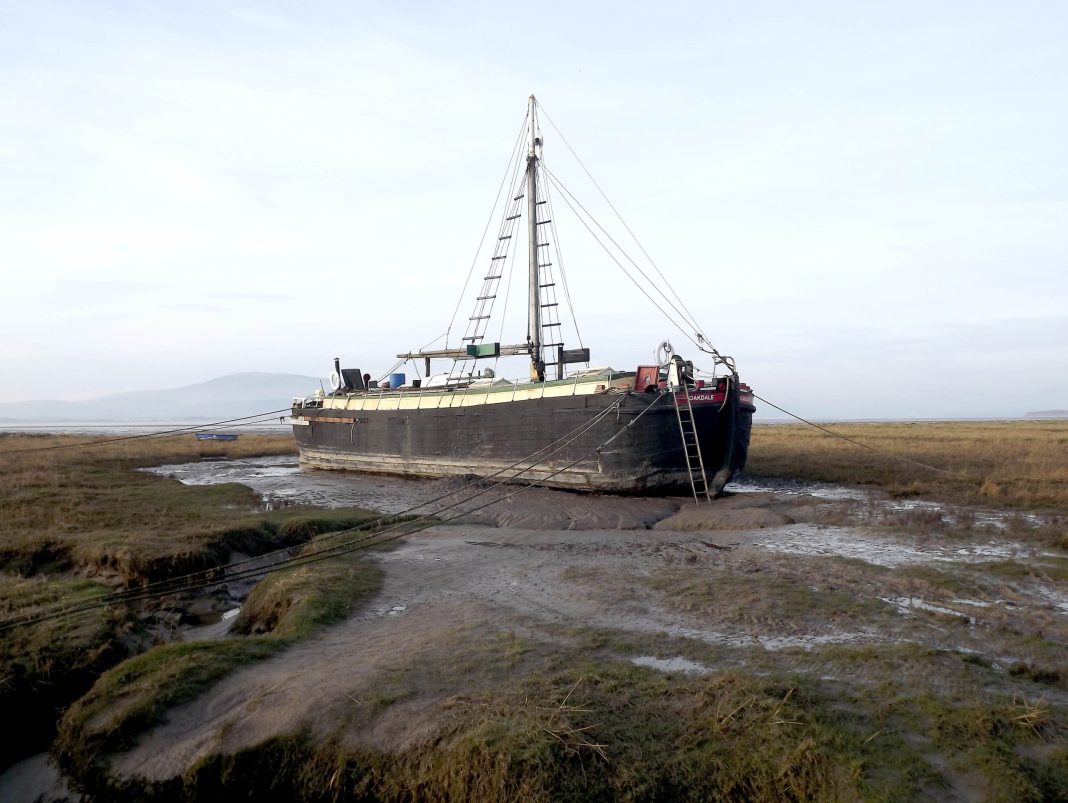A Unique Survivor of a Bygone Age and a Key Piece of North West Maritime History
The last remaining Composite Mersey flat, Oakdale, is also the last known surviving commercial sea-going vessel built in Runcorn.
Of the Mersey flats built across the region (along the Mersey, Weaver, and other local rivers and canals, and across the north-west from Anglesey to southern Scotland), only two now survive: Mossdale, built in Chester but later bought and refitted by Abel’s of Runcorn, now in the hands of the Boat Museum at Ellesmere Port; and Oakdale, beached at Askam-in-Furness and once used as a houseboat by her owner and restorer, David Keenan.
Keenan has plenty of experience and knowledge of local maritime affairs (having worked in the coastal trade for many years, including as master of the Oakdale) and clearly loves the vessel, realising her unique status. The work, however, is now getting beyond his ability to achieve on his own and a new group has been set up to keep the vessel going.
Oakdale Mersey Flat Trust has been founded under Roger Murray, Martin Dewhurst, and others, with the aim of fully restoring her and then, when she is safe to be towed or taken by submersible barge, to return her to the Mersey, to her birthplace of Runcorn.
Ultimately, the aim is to found a heritage boatyard with a patent slipway. This is a facility where carriages run into the water on rails, and underneath a vessel, which can then be hauled clear of the water to conduct surveys, repairs, or painting.
The Trust hopes to set up at the site of Oakdale’s launch, Castlerock (immediately east of the railway bridge, beside the Manchester Ship Canal), or further along Runcorn Waterfront at either the site of the former Belvedere Yard (whose slipway rails can still be seen entering the Ship Canal) or the old Town Slip, beside the new housing development of the Decks.
This latter site is where Old Quay Yard once maintained the vessels of the Manchester Ship Canal Company and was one of two patent slipways the company once ran there. This slipway also still has her old rails entering the water, but into a small dock (or basin) beside the canal. For many years, it was leased by a firm run by the Stubbs family, and many of the older generations of local people still refer to it as “Stubbs’ Slip”.
The most modern flats were composite-built, so had steel frames and wooden planking. Later developments led to the invention of motor-engined Weaver Packets.
In much the same way that we can consider the Weaver Packet as the most modern development of a Mersey flat, the design being taken to its natural conclusion in those motor vessels, Oakdale represents the same level of development along the traditional sailing line (although initially built without being fitted for a full set of sails and designed to be a “dumb barge” for towing) and is therefore a vessel of great historical importance.
Furthermore, she is one of only a few surviving composite-built former working vessels in the world (alongside the City Of Adelaide in Sydney, the Cutty Sark in London, HMS Gannet in Chatham, the Thames Barge Raybel, and the beached remains of Ambassador in Chile), making her a craft of international significance.
Oakdale was the second-to-last flat ever constructed and was launched at the Castlerock Yard of Richard Abel & Sons, having been built to the same designs that the firm used back into the 1850s for the many vessels they created for themselves and for other concerns.
She is a sistership of the last ever flat, the Ruth Bate (built for the boat-owning family of the same name). Sadly, Ruth Bate has already been scrapped.
Oakdale was built for the company’s own use and worked for Abel’s until 1963 when they ceased trading. She was sold to Rea’s who later sold her on in 1966. She was then sold to a man who wished to make her into a floating restaurant, but the plans fell through.
Dave Keenan bought her when she was lying in deep mud at Burscough near the pub whose landlord was trying to open her as an eatery. Dave took her to Brunswick Dock in Liverpool and went about the surviving barge companies to buy the necessary spares before refitting her at the Bootle Barge Company.
Statistics
Launched on 15 September 1951 after an 18-month build
Dimensions: 72ft 6in x 15ft 9in x Depth 3ft (6ft 6in moulded depth)
Power: Lister HA3 Diesel Engine (fitted 1957)
Tonnage: 66grt, 63 net, 52 tons displacement in working order
Cargo Capacity: 120 Tons
Official Number: 183820
In one of the pictures Oakdale can be seen on the patent slipway at Castlerock, shortly before launch, with the men who built her. The photograph was supplied by Ted Hill, who has been helping us with our understanding of the yard and how she operated. He was apprenticed to Abel’s and then became a full shipwright for them. He can be seen in the centre rear of the group, with his head just left of the ‘O’ in Oakdale.


